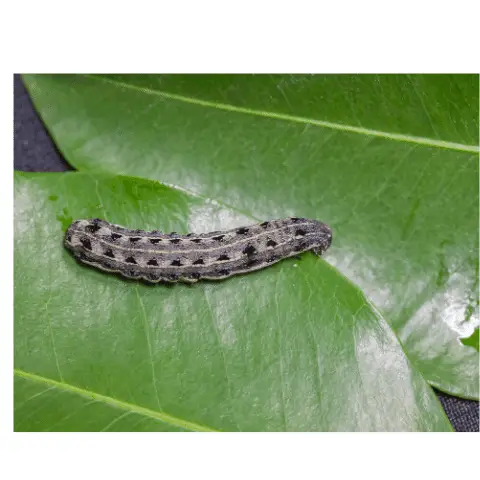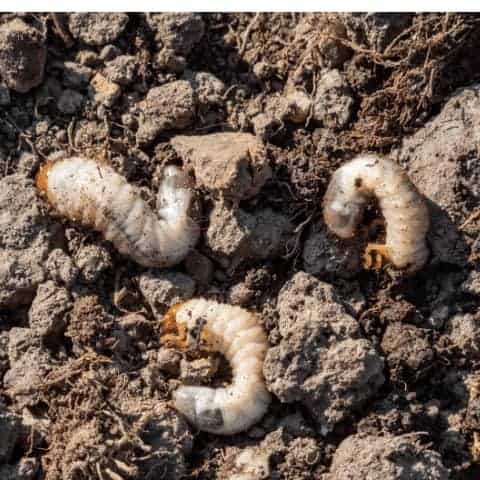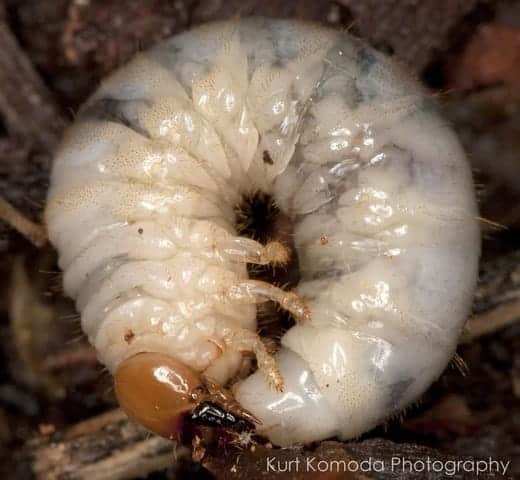Often even the more experienced gardeners tend to confuse cutworms with grubs, although between the two there are substantial differences. In this article I want to share with you, all there is to know about these two critters, how to identify them to protect our crops.
Cutworms and grubs are not the same thing.
What’s the difference between Cutworms and Grubs?
Cutworms are dark moth larvae and can seriously damage your vegetable garden. Grubs are scarab beetle larvae that can harm your garden and lawn as well, although they have few good qualities that we will discuss later.
Let’s take a better look and see how to identify them.
Who is the infamous Cutworm, the dread of many fellow gardeners?

Are you also one of those gardeners who are amazed to find in the morning that their vegetables lay broken dead on the soil and cannot give a reason for it? Know that you are not alone! Your garden is under the attack of cutworms.
First of all, cutworms are caterpillars, not worms. They are dark-winged moth larvae and are about 1-2 inches long. They are soft-bodied caterpillars with colors that range from grey to black, green, spotted, or striped. Black cutworms are the most common. They are known to curl up when resting or when touched.
The moths lay their eggs in the fall, directly on the soil. About a week later the eggs hatch and the larvae overwinter under the soil, waiting for warmer days. As soon as spring comes the larvae become very active and start to feast on your vegetable garden causing severe damages. The cutworm, as its name suggests, is particularly harmful since it loves young plants and feeds by clipping off seedling stems near the soil surface. It is a nocturnal critter: active from dusk to morning and hiding under the soil during the day.
When numerous, cutworms can eat and destroy an entire row of vegetables in just one night! On warmer days, cutworms can sometimes crawl to the top of plants which adds to the damage. Moreover, they multiply very frequently, so you will likely end up with a few generations of cutworms in just one season! Their destructive power however is only limited when they are in the larvae stage. Once they become adult moths they do not damage the garden.
- Cutworms are fond of these plants:
- Beets
- Broccoli
- Cabbage,
- Cauliflower,
- Corn
- Grass
- Green Beans
- Kale
- lettuce
- Potato.
10 Ways To Get Rid Of Cutworms Organically
As always, when it comes to our vegetables, it is preferable to use organic products so as not to harm ourselves, our pets, and as well as all the beneficial insects that dwell in our garden.
Here are 10 ways to get rid of cutworms FOR GOOD:
- Handpick them in the dark using a flashlight. I need to be honest here: when I first heard of this solution I thought people were joking. But it’s true. You can either try to do this at dusk or during the daytime by digging close to your plant’s stem. I find this a bit time consuming and dangerous for the plant, since digging too close to their roots may damage them. If you choose this method, you should repeat the hunts for a few nights in a row to make sure you get rid of them all. This solution is good if you have a minor infestation.
- Water the soil of your crops abundantly. Cutworms will emerge, you can then pick them up and kill them.
- Spread some Diatomaceous Earth (known also as D.E.) on the soil, around your seedling. D.E. is the fossilized remains of diatoms. It is largely considered harmless to people and pets and can kill insects within 48 hours by dehydrating them to death. This product has hundreds of uses and is available on Amazon.
- Make plant collars out of empty paper towel rolls or plastic pipes. This will create a natural barrier that will go a few inches below the soil and above it. This way the cutworms will not reach the plant. Again, this is quite time consuming, so it is advisable only for a small garden.
- Release some beneficial Nematodes on the ground. Beneficial Nematodes are microscopic roundworms that will enter the larvae’s body through the mouth, anus, and their respiratory openings. Then, they will release their bacteria, killing their host within 48 hours. Once they kill it, they will transform the host’s body into nutrient upon which they will feed. These are the best ones against cutworms and grubs.
- Release Trichogramma Wasps around the same time when moths first appear in your garden. (Which is the time they lay their eggs). Trichogramma are tiny wasps that kill the moth’s eggs by laying their eggs inside the much larger eggs of the moth. The Trichogramma egg hatches into a small larva and feeds on the inside of the moth egg, killing it. You will need to release the wasps 3 weeks in a row to make sure you get rid of all the cutworm eggs.
- Sprinkle a mix of coffee grounds and crushed eggshells around your plants.
- Mulch your plants with Oak leaves. This will irritate the cutworm and repel it.
- Grow Tansy close to your crops. Tansy is known for repelling moths, however, keep in mind that this plant is toxic to humans and pets.
- Apply some B.T. (Bacillus Thuringiensis) to the soil. What’s good about this insecticide is that it is completely organic and targets specifically caterpillars. The caterpillar will ingest the B.T. and die from it. It is harmless to humans. Please take into consideration that it may harm butterflies as well, which are highly beneficial to our gardens.
Here Is How To Prevent The Infestation From Cutworms:
- Before planting new crops, turn over the soil a few times. This will allow the birds to come and feed on the larvae and pupae.
- Moths like to lay eggs in high grass and weeds. Remove weeds and plant debris regularly, especially at the end of the season. Mow as close as possible to the area of your vegetable garden to prevent cutworms from nesting and feeding. It would be good to have some distance between your lawn and your vegetable garden. A soil strip will do the job and will give you a chance to spot the cutworms that want to reach your vegetable garden.
- Plant Sunflowers around your vegetable garden as a “trap crop”. The cutworms love to munch on them and will drive them away from your beloved crops.
- If possible, try to delay transplanting your seedlings by two or three weeks. This might starve them since Cutworms become more active as soon as spring begins.
What are Grubs?
Lawn or White Grubs are nothing more than scarab beetle larvae, like the Japanese beetle, Masked Chafers, and June Beetles.
They are soft-bodied caterpillars about 1-2 inches long with white bodies and brown face. Adult female beetles lay their eggs in mid-summer. The eggs hatch in late summer and the larvae burrow deep in the soil to overwinter. As the soils warm in spring, they become active and resurface hungry and ready to feast on your garden.

Are Grubs Good For Your Garden?
OK, let’s start with the good, just to give them some credit. Not all white grubs are considered pests. When associated with manure certain types of white grubs break down the cellulose in your gardens and potted plants converting it into nutrients. These types of grubs are not the ones that feed on the roots of your plants and you don’t need to kill them. One of these is the Bumble Flower Beetle (Euphoria inda) which are beetles that pollinate flowers and decompose organic matter.
Are Grubs Bad For Your Garden?
Unfortunately, a lot can be said against grubs. Grub worms feed on grassroots and eventually turn into adult beetles that eat the leaves of other plants in your garden. They can seriously harm your lawn if their population gets out of hand. You are facing a grub infestation if you see these signs:
- An increased number of birds in your garden (they are there because they like to feed on them)
- You see a large number of grubs while digging in your garden
- Your plants have holes and chewed leaves
- Your lawn have “holes”

How to get rid of grubs NATURALLY:
If not treated properly, the infestation can grow exponentially in the coming years. Here are some ways to kill them:
- Release some beneficial Nematodes on the ground. Just like for the cutworms, the beneficial nematodes will do the work. Want to know more about beneficial nematodes? Read here about how and when to apply on your soil and lawn.
- Spray them with a vegetable oil spray. This is how you can make the spray on your own: mix 1tsp of dish soap, two cups of water and 2 tbs of vegetable oil and some alcohol. Shake well and spray directly on the plants. Better in the early mornings or evenings, not in the hottest part of the day. As with all natural pesticides: better test it on a small portion of the plant and if you see no damage the next day, continue the treatment.
- Handpick them manually. It’s time-consuming but it is quite effective.
- Attract birds into your garden. They will gladly take care of your grub problem.
- Make a Neem Oil Spray. Neem oil is considered a powerful natural pesticide. Here is how you can make your homemade spray: Mix ½ ounce of organic Neem oil, ½ tsp of dish soap with two quarts of warm water. Pour into a spray bottle and use it immediately.
- Prevent the attack of grubs by planting a lawn that is particularly resistant to these insects such as Ryegrass or Fescue.
… and last, but not least, a warning: when dealing with pesticides do not forget to protect your eyes and wear gloves. Keep all pesticides away from the reach of children and pets!
Some of the links above are affiliate links, meaning, at no additional cost to you, I will earn a commission if you click through and make a purchase.
Hope you enjoyed my post! You might also be interested in these articles:
When Is The Best Time To Apply Beneficial Nematodes?
How To Identify Symptoms Of Root-Knot Nematodes In The Garden
